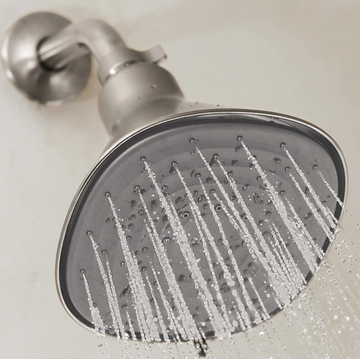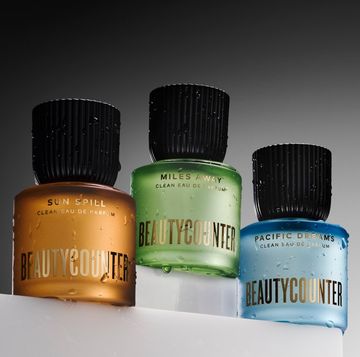Breathing hasn’t always gotten the respect it deserves. We’ve always known that it keeps us alive, in an automatic and largely unthought of way, but now, we are living in a time when breath has never felt more sacred—becoming eerily significant as a respiratory virus ravages the globe. But almost concurrent with the spread of COVID, the practice of breathwork has gained momentum and entered the realm of pop culture.
The Goop Lab with Gwyneth Paltrow debuted on Netflix in late January 2020, a few weeks before the world shut down. In a popular episode highlighting Dutch extreme athlete Wim Hof’s soft belly breathing and cold-resistance training for physical and psychological healing, we watched from the comfort of our couches as Goop employees plunged into a freezing-cold lake. By the time Justin Bieber called him a “G” on The Ellen DeGeneres Show in December 2020, and reported DM-ing with him on Instagram (as one of his 1.6 million followers), the self-proclaimed “crazy Dutch man” was practically a household name. Jasmine Marie, founder of Black Girls Breathing has specifically sought to center Black women in the conversation around the healing power of breathwork. Breathwork had gone mainstream, practiced by influencers and spiritual seekers alike.
But breathwork is hardly new. A particular reverence for the breath as a conduit of life force energy goes back thousands of years in spiritual traditions and Eastern practices; breathing through the physical postures is a critical component of yoga, while counting your breaths is the backbone of certain meditative traditions. “Most breathing practices come from ancient yoga traditions and are based on pranayama, which means ‘the regulation of the breath through certain techniques and exercises,’” says Jay Bradley, founder of BreatheOnIt and Chakra Balms, who teaches a three-part, circular breath technique.
The draw of the practice largely comes down to the transformational potential a practice has on the mental state. Regular practitioners claim mental improvements such as overcoming depression, managing addiction, and/or having a more compassionate self-view. But even in our modern world, the spiritual component cannot be ignored. “The depth of practice, experience of the practitioner, and the trust and willingness of the person are what can elevate a simple technique to a whole other level of sacred, even in a less typical-seeming, spiritual context,” explains Erin Telford, a breathwork instructor.
For the skeptics: Medicine also confirms claims of its physical benefits. “There are so many studies that show deep breathing is one easy, accessible practice that can help to balance the mind and body, and reduce the stress response,” says Mark Hyman, M.D., a 13-time New York Times best-selling author and the head of strategy and innovation at the Cleveland Clinic Center for Functional Medicine. “Breathwork has been shown to increase parasympathetic activity, heart rate variability, physiological flexibility, [and] is one of the greatest tools I have in my medical toolbox to help individuals manage stress, [which] has become an epidemic in our society.”
Read on for everything you need to know about starting and maintaining a breathwork practice.
What is a breathwork practice?
As Shel Pink, founder of SPARITUAL and a proponent of breathwork in Slow Beauty, puts it, “Breathwork can be the meditation, or breathwork can be the focus or the intention of the meditation.” Put differently, “Breathwork is an active meditation technique that uses breath to purge the body and nervous system of emotional debris,” says ALTYR practitioner Rony Ghoraishy, a yoga and holotropic breathwork teacher. “[It facilitates a] disconnection from the mind and thoughts, and a connection to the heart.”
The relaxing effects of a class can be immediate, but profound cumulative effects come from turning your sessions into regular occurrences. “If someone is looking to speed up their emotional healing, doing a breathing technique [for 20 to 28 minutes] every day for one to two weeks is a wonderful kick-start,” advises Bradley. “For maintenance, to stay centered and balanced, one to two times per week is recommended.”
If you don’t have a ton of time though, Erika Polsinelli, a Kundalini breathwork teacher and the founder of Evolve by Erika, explains that every little bit counts. “Ideally, a 20- to 30-minute practice in the morning would be wonderful. However, even just spending three minutes each morning consciously breathing can help change the projection of your entire day.” She recommends practicing in the mornings, because the brain’s relaxed; a sleepy state can help you achieve a meditative headspace more quickly and with fewer distractions.
How exactly does breathwork, work?
Of the hundreds of schools of breathwork, and within them, various breath types (i.e., circular, boxed, ujjayi, breath of fire) and techniques (i.e., nostril breathing, opposite nostril breathing, mouth breathing, breath holding), the healing mechanism remains the same: the mind-body connection. In 1975, Harvard physician Herbert Benson coined the term relaxation response, the body's innate stress-countering mechanism courtesy of the parasympathetic nervous system. His research showed that you could use relaxation techniques (i.e., meditation) to quell the physiological fight-or-flight response, or stress response.
“Research has shown over and over again that learning to relax is one of the most important keys to long-term health and vitality,” Hyman says. “That doesn’t mean sipping a glass of chardonnay while watching TV or practicing retail therapy. You have to learn how to deeply relax and stimulate your vagus nerve.” He explains that the vagus nerve connects to all the body’s immune cells, stem cells, organs, and tissues, and that it has the ability to turn off your stress response and activate your relaxation response, making it incredibly healing to the nervous system. “Your stress response gets turned on automatically day after day. However, very few of us know how to calm this system down, [and] this is a serious health concern, because stress is very bad for your brain. Breathwork is one of the most powerful tools we have to activate the vagus nerve and improve the brain and mind-body connection.”
What does a breathwork session feel like?
During a class, your breathwork teacher first guides you through the specific breathing technique in which they are trained. Once you begin breathing, they might play inspirational music, have you incorporate aromatherapy or crystal therapy into your session, and finish with a guided meditation or even Reiki healing. Breathwork can be practiced just as effectively remotely, and even alone, but the presence of an instructor is suggested to guide you through the sometimes physically and emotionally intense experience.
Ghoraishy teaches a form of holotropic breathwork consisting of a two-part inhale and one-part exhale through the mouth. In a session with her, she also pulls an Inner Compass Meditation Card to help you set an intention for the practice. “Everyone remembers their first breathwork session,” she says. “For me, it was the emotional release, the freedom, and liberation from my thoughts, and the flooding of gratitude that brought me back to the practice again and again.” She felt drastically better after each session, and found it to be so healing that she decided to get certified in order to teach the self-help tool to others. “I have seen breathwork serve as an emotional release for people struggling with stress, anxiety, PTSD, and depression. Some of the most profound shifts I have seen are an overall increased mind-body connection and emotional purging,” says Ghoraishy.
Speaking from experience, it can feel like your hands are vibrating. You may experience temperature changes, lightheadedness, tingling, or tetany—where your hands temporarily spasm into a clawlike position. (The first time I experienced it, during a session with Ghoraishy, I couldn’t wait to tell her. It took a few minutes before I could type or text again.)
Emotional release is also common, as unconscious emotions that have been stored in the body bubble their way up to consciousness. Subconscious thoughts, memories, insights, emotional realizations, and even creative inspiration can arise; lines of this article spontaneously came to mind in the middle of a session with Bradley. It happened after painful, lingering, psychosomatic pressure in my throat (what metaphysically minded folks would call an energy block in the throat chakra, the energy center associated with self-expression and speaking your truth) dissipated—much to my relief—after 30 minutes of breathing with a kyanite crystal on my blanket, essential oil-infused ChakraBalms, and Bradley as my guide.
Many also report losing a sense of time. Once your body enters a state of deep relaxation, timelessness takes over; it reminds me of the state between wakefulness and sleep that is induced by acupuncture, a modality that always leaves me clueless as to how much time has passed or whether I have fallen asleep. After 20 to 30 minutes of breathwork, you emerge from the depths of your inner mind and shift your focus back to the environment. You feel clarity, lightness, and energized, having sent oxygen through the blood to the body’s vital organs. This, of course, is all connected to the body’s parasympathetic nervous system activity. But the experience of the relaxation response is like a miniature vacation from the stress of life—and in this case, your breath is the only vehicle needed.
How does breathwork contribute to stress relief?
At the core, breathwork is a stress-reduction technique that brings physical relaxation and peace of mind. Naturopathic doctor Nadia Musavvir explains, “Shallow breathing (or not breathing) sends the message to the brain that you are under threat. You can interrupt this by simply taking a pause to breathe. The longer you exhale, the more the lungs can expand and send a signal to the brain that you are not in any imminent danger.”
Breathwork also brings physical changes to the chemistry of the body, reducing the stress hormones like cortisol and releasing the pleasant “cuddle hormone” oxytocin. Alterations to your perspective, when less influenced by stress, provide you with the ability to reframe your world view more positively, while making other thought processes—like stress-exacerbating rumination—less prevalent. “Breathwork has helped me break old patterns and recurring thoughts,” breathwork facilitator Nadia Josse, who also works in the luxury fashion industry, tells us. “I made peace with some childhood traumas that were impacting my daily life.” (As Dr. Hyman points out, trauma is kept in both the mind and body, which is why, he says, mind-body healing modalities can bring around long-term healing.)
Of her journey to breathwork, Josse says, “I found breathwork first a few years ago. I don’t think I was prepared to have such an intense experience at that time.” After exploring breathing techniques during yoga, and even the Wim Hof Method, she resonated with the technique taught through Lara Elliott, and then Erin Telford. “Every time I would go back to the breath, I would have an intense experience, sometimes even a breakthrough,” says Josse. “You feel the effects during the session but also after—behaviors change, you start seeing the world differently without the lenses of your conditioning and traumas. Of course, this is all if you desire to do the work and change for the better.”
Users also report a better relationship to themselves; a healthier, more harmonious, compassionate experience within their minds as they tune in and observe their inner processes. “The biggest impact that breathwork has had on my life is that it has magnified my sense of self-love and self-acceptance,” says Bradley. “I was always my worst critic and had a pretty judgmental view of myself. I now treat myself with gentleness, kindness, and support.” Bradley describes a past of suffering from depression and how, over time, his practice allowed him to separate from his depression experientially, becoming more of an observer. “[Now], I watch my pain with less attachment, helping me to remain calm, balanced, and centered, even in the midst of high-stress situations,” he says.
This ability to access mindful equanimity can help to promote emotional stability and create inner peace. “Many people are still struggling with feeling safe and at home in their bodies and with their emotions,” explains Telford. “This practice allows you to learn how to be with yourself and the many ebbs and flows of the human experience. … It connects you to the part of you that already knows, the part of you that holds embodied truths and wisdoms.”
Breathwork and Generational Trauma in the Black Community
"I know this work can help relieve the chronic stress and trauma that marginalized and oppressed communities face," says Jasmine Marie, breathwork practitioner, and founder of Black Girls Breathing and House of BGB, an organization that holds space for hundreds of Black womxn per month in order to address an evidence-substantiated healthcare gap. "I have seen and felt the impact of not only providing breathwork, but a safe space where issues specific to the Black community—that have an impact on their mental health—are addressed." This is significant because as breathwork becomes mainstream, it highlights existing inequities in accessibility that impact minority communities. Transcendental Beauty Practitioner Taryn Dean points out that the BIPOC community faces unique psychosocial stressors surrounding systemic racial disparities that impact and include healthcare and health outcomes, making it "imperative that we champion any resource that moves therapy away from a culture of elitism" in favor of accessibility and necessity. "We so rarely address how the daily stressors and the long-term ancestral [trauma we carry] feels in our bodies," continues healer, breathwork facilitator, and founder of Wellness Official, Millana Snow, who merges holotropic breathwork into her energy healing sessions with clients. Snow noted from client experiences that it synergistically enhances the healing. "Breathwork helps us to get to the deeper things that we have held for our ancestors that we were unaware that we were carrying and gives us a vehicle to release those burdens," she explains.
A conversation with breathwork practitioner Susan Ateh drove home the importance of representation as breathwork gains mainstream notoriety, emphasizing the work of Breathwork for the People in their ongoing dialogue with. "Every human should feel that they deserve and have a space to heal," she says. "Representation matters enormously in this work... as breathwork gains popularity, we must be conscious it doesn't exclude those who need it the most, [becoming] another healing accessed by the privileged few."
Why should you try breathwork now?
As research verifies what we already know about the adverse mental health consequences of 2020, the isolation of our socially distant lifestyles makes individualized, self-directed practices like breathwork uniquely suited for our “new normal.” The ability to induce the body’s sense of calm imparts a sense of self-mastery that can help to restore the “locus of control”—something that we need during times of uncertainty. The flexibility of breathwork lies in how it can be practiced alone or remotely; even if you choose to have a session with a teacher, you can easily complete it over Zoom. And like anything that goes mainstream, the presence of breathwork in pop culture makes it feel relatable and relevant.
A growing need for meaningful relief has been met by the booming wellness industry. Camrin Agin, who founded ALTYR to make wellness practices accessible, considered the intricacies of the market when it came to selecting her offerings and found that breathwork warranted a place in her menu of services. “What’s interesting about wellness is that it can be a very active, conscious endeavor just as much as it can be a passive, unconscious one,” Agrin says. “Meditation, breathwork, and readings all fall into the former category, while Reiki, sound baths, and yoga nidra fall into the latter. Sometimes it’s important to take charge of our own bodies, while other times, it’s important to have another audit them for us.”
The varied experiences afforded by breathwork can be seen as the public embracing the grounding return to the present moment, where we can face and cope with heightened stress (which often takes us to the future or to revisit the past) as we move forward into an uncertain future. “To me, the popularity of breathwork in the mainstream means that we have reached a new level of readiness in the collective to face our shadows, to learn to trust our bodies and our intuition again, and to heal more deeply,” Telford says.
For many, the heart of the matter is the need to feel okay again—and breathwork is proving itself a popular and effective means for trying to do so. “The quality of our breath is what connects us to our lives,” says Pink. “When my breathing is deeper, I feel more connected in the present, calmer, and life feels more meaningful and purposeful.”
This article has been updated to reflect the unique role of breathwork within Black communities.














